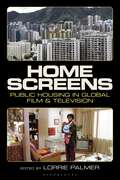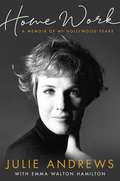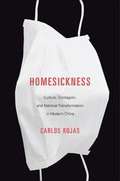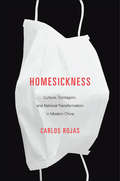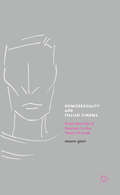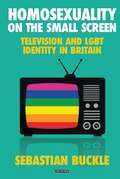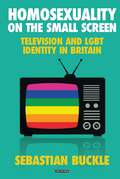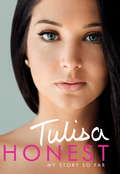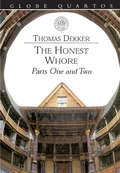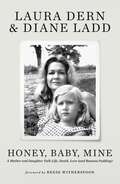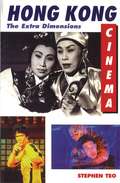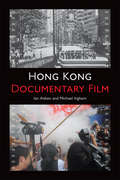- Table View
- List View
Home Screens: Public Housing in Global Film & Television
How do film and television makers around the world depict public housing? Why is public housing so often chosen as the backdrop for drama, horror, social critique, rebellion, violence, artistic creativity, explorations of race relations and political intrigue?Home Screens answers these questions by examining the ways in which socialized housing projects around the world are represented on screen. The volume brings together a diverse group of interdisciplinary scholars, who explore documentary and fictional portrayals of the architecture of public housing, and the communities that inhabit it, ranging from the 1950s to the present. Examining international film and media texts such as Die Architekten (1990), Swagger (2016), Cooley High (1975), Mee-Pok Man (1995), Treme (2010–2013), Mamma Roma (1962), The Pruitt-Igoe Myth (2011), and Below the Lion Rock (1972–1976), essays within this book consider public and private attitudes toward socialised housing, explaining how onscreen representations shape perceptions of these ubiquitous, often-stigmatized urban locations.
Home Work: A Memoir of My Hollywood Years
by Julie AndrewsIn this follow-up to her critically acclaimed and bestselling memoir Home, the enchanting Julie Andrews picks up her story with her arrival in Hollywood, sharing the career highlights, personal experiences and reflections behind her astonishing career, including such classics as Mary Poppins, The Sound of Music, Victor/Victoria and many others.In Home, Julie Andrews recounted her difficult childhood and her emergence as an acclaimed singer and performer on the stage. In her new memoir, Julie picks up the story with her arrival in Hollywood and her astonishing rise to fame as two of her early films -Mary Poppins and The Sound of Music- brought her instant and enormous success, including an Oscar. It was the beginning of a career that would make Julie Andrews an icon to millions the world over. In Home Work, Julie describes her years in Hollywood - from the incredible highs to the challenging lows. Not only does she detail her work in now-classic films and her collaborations with giants of cinema and television; she also unveils her personal story of adjusting to a new and often daunting world, dealing with the demands of unimaginable success, being a new mother, moving on from her first marriage, embracing two stepchildren, adopting two more children, and falling in love with the brilliant and mercurial Blake Edwards. The pair worked together in numerous films, culminating in Victor/Victoria, the gender-bending comedy that garnered multiple Oscar nominations. Told with her trademark charm and candour, Julie Andrews takes us on a rare and intimate journey into an astonishing life that is funny, heartbreaking and inspiring.
Homemade Men in Postwar Austrian Cinema: Nationhood, Genre and Masculinity (Film Europa #15)
by Maria FritscheDespite the massive influx of Hollywood movies and films from other European countries after World War II, Austrian film continued to be hugely popular with Austrian and German audiences. By examining the decisive role that popular cinema played in the turbulent post-war era, this book provides unique insights into the reconstruction of a disrupted society. Through detailed analysis of the stylistic patterns, narratives and major themes of four popular genres of the time, costume film, Heimatfilm, tourist film and comedy, the book explains how popular cinema helped to shape national identity, smoothed conflicted gender relations and relieved the Austrians from the burden of the Nazi past through celebrating the harmonious, charming, musical Austrian man.
Homesickness: Culture, Contagion, And National Transformation In Modern China
by Carlos RojasCarlos Rojas focuses on the trope of “homesickness” in China—discomfort caused not by a longing for home but by excessive proximity to it. This inverse homesickness marks a process of movement away from the home, conceived of as spaces associated with the nation, family, and individual body, and gives rise to the possibility of long-term health.
Homesickness: Culture, Contagion, And National Transformation In Modern China
by Carlos RojasCarlos Rojas focuses on the trope of “homesickness” in China—discomfort caused not by a longing for home but by excessive proximity to it. This inverse homesickness marks a process of movement away from the home, conceived of as spaces associated with the nation, family, and individual body, and gives rise to the possibility of long-term health.
Homeward Bound: The Life of Paul Simon
by Peter Ames CarlinTo have been alive during the last sixty years is to have lived with the music of Paul Simon. The boy from Queens scored his first hit record in 1957, just months after Elvis Presley ignited the rock era. As the songwriting half of Simon & Garfunkel, his work helped define the youth movement of the '60s. On his own in the '70s, Simon made radio-dominating hits. He kicked off the '80s by reuniting with Garfunkel to perform for half a million New Yorkers in Central Park. Five years later, Simon's album "Graceland" sold millions and spurred an international political controversy. And it doesn't stop there.The grandchild of Jewish immigrants from Hungary, the nearly 75-year-old singer-songwriter has not only sold more than 100 million records, won 15 Grammy awards and been installed into the Rock 'n' Roll Hall of Fame twice, but has also animated the meaning?and flexibility?of personal and cultural identity in a rapidly shrinking world.Simon has also lived one of the most vibrant lives of modern times; a story replete with tales of Carrie Fisher, Leonard Bernstein, Bob Dylan, Woody Allen, Shelley Duvall, Nelson Mandela, the Grateful Dead, drugs, depression, marriage, divorce, and more. A life story with the scope and power of an epic novel, Carlin's Homeward Bound is the first major biography of one of the most influential popular artists in American history.
Homo Ludens as a Comic Character in Selected American Films (Second Language Learning and Teaching)
by Artur SkweresThis book reveals the hitherto critically disregarded ludic elements in popular American comedy films, building on and expanding the theories developed by Johan Huizinga in his classic study Homo Ludens (1938) and Roger Caillois in Les jeux et les hommes (1958). To address the lack of attention paid to the play principle in film comedy studies, this book focuses exclusively on the elements typical of play that can be found in movies. It introduces two new categories describing play: óneiros and pragma, which allow analysis of how play in comedies is influenced by the relations between the player and non-players. The text is supplemented by the use of the author’s drawings, which, because of their analytical and selective nature, are used as a tool for visual study. The play principle has a long tradition in American humor and the films examined here were chosen for their popularity and wide appeal, often acting as vehicles for Hollywood stars (e.g. Chevy Chase, Dan Aykroyd, Bill Murray, Steve Martin, Eddie Murphy, Goldie Hawn, Mike Myers, Jackie Chan or Chris Tucker). The actors’ status allowed the filmmakers to construct situations in which the protagonists distanced themselves from the fictional situation. It is argued that the playful detachment from reality, typifying many of the fictional characters portrayed by actors with star status, is characteristic of the play principle in film. Another major consideration is the hotly debated notion of the accomplishment of goals in playful activities, and the book strongly supports the position that in narratives, play can (but does not have to) yield important results. The introduction of the categories of óneiros and pragma in play serves to highlight the complex relation between playfulness and practicality in the films discussed. Building on a comprehensive analysis of the ludic elements in selected popular American comedies, the book makes an important contribution to film studies, providing a unique perspective through its focus on the concept of homo ludens as a comic hero.
Homosexuality and Italian Cinema: From the Fall of Fascism to the Years of Lead
by Mauro GioriThis book is the first to establish the relevance of same-sex desires, pleasures and anxieties in the cinema of post-war Italy. It explores cinematic representations of homosexuality and their significance in a wider cultural struggle in Italy involving society, cinema, and sexuality between the 1940s and 1970s. Besides tracing the evolution of representations through both art and popular films, this book also analyses connections with consumer culture, film criticism and politics. Giori uncovers how complicated negotiations between challenges to and valorization of dominant forms of knowledge of homosexuality shaped representations and argues that they were not always the outcome of hatred but also sought to convey unmentionable pleasures and complicities. Through archival research and a survey of more than 600 films, the author enriches our understanding of thirty years of Italian film and cultural history.
Homosexuality on the Small Screen: Television and Gay Identity in Britain (International Library of Cultural Studies)
by Sebastian BuckleTelevision provides a unique account of the development of a homosexual identity across the western world, emerging as it did when ideas around sex and sexuality were themselves only just beginning to be publicly discussed. From the very earliest surviving drama featuring homosexuality in 1959, Homosexuality on the Small Screen explores each decade's programming in turn, looking at homosexual themes, storylines, and characters, situating them historically, and relating them to the broader events in British history. By doing so it examines the interactions between the medium and the reality of gay lives, showing how television mirrored the changes taking place in British society. For those with a homosexual - or emerging homosexual - sexual orientation, they were seminal in early personal and social development. For heterosexual viewers, these images were equally important in exploring a sexual other which otherwise remained hidden from them. They included positive storylines which helped improve public ideas about homosexuality, but also stereotypical images which propagated negative attitudes in the public consciousness.Homosexuality on the Small Screen charts this fascinating journey and television's role in the construction of a gay identity.
Homosexuality on the Small Screen: Television and Gay Identity in Britain (International Library Of Cultural Studies)
by Sebastian BuckleTelevision provides a unique account of the development of a homosexual identity across the western world, emerging as it did when ideas around sex and sexuality were themselves only just beginning to be publicly discussed. From the very earliest surviving drama featuring homosexuality in 1959, Homosexuality on the Small Screen explores each decade's programming in turn, looking at homosexual themes, storylines, and characters, situating them historically, and relating them to the broader events in British history. By doing so it examines the interactions between the medium and the reality of gay lives, showing how television mirrored the changes taking place in British society. For those with a homosexual - or emerging homosexual - sexual orientation, they were seminal in early personal and social development. For heterosexual viewers, these images were equally important in exploring a sexual other which otherwise remained hidden from them. They included positive storylines which helped improve public ideas about homosexuality, but also stereotypical images which propagated negative attitudes in the public consciousness.Homosexuality on the Small Screen charts this fascinating journey and television's role in the construction of a gay identity.
Honest: The Official Autobiography
by Tulisa ContostavlosTulisa Contostavlos is one of the most talented and high-profile recording artists working in the UK today. She has three platinum N-Dubz albums, four MOBO awards, a groundbreaking drama series, two documentaries, a MIND award and an X Factor judge's win under her belt. Not bad for a girl who's not yet twenty-four. But this is not just a tale of glittering success. Tulisa grew up on a tough London estate and left school with no qualifications as she struggled to cope with deep-seated emotional problems while caring for her mother alone. She has seen first hand what drugs, alcohol, gang culture and violent relationships can do to young people, but she has come through it all to become the confident, inspiring artist she is today. After taking her little muffins Little Mix to the winning spot of the X Factor at the end of 2011, and with her long-awaited solo album being released later this year, the future is bright for Tulisa. Told in her own words, this is her story.
HONEST BODIES C: Revolutionary Modernism in the Dances of Anna Sokolow
by Hannah KosstrinHonest Bodies: Revolutionary Modernism in the Dances of Anna Sokolow illustrates the ways in which Sokolow's choreography circulated American modernism among Jewish and communist channels of the international Left from the 1930s-1960s in the United States, Mexico, and Israel. Drawing upon extensive archival materials, interviews, and theories from dance, Jewish, and gender studies, this book illuminates Sokolow's statements for workers' rights, anti-racism, and the human condition through her choreography for social change alongside her dancing and teaching for Martha Graham. Tracing a catalog of dances with her companies Dance Unit, La Paloma Azul, Lyric Theatre, and Anna Sokolow Dance Company, along with presenters and companies the Negro Cultural Committee, New York State Committee for the Communist Party, Federal Theatre Project, Nuevo Grupo Mexicano de Clásicas y Modernas, and Inbal Dance Theater, this book highlights Sokolow's work in conjunction with developments in ethnic definitions, diaspora, and nationalism in the US, Mexico, and Israel.
The Honest Whore (Globe Quartos)
by Thomas DekkerFirst Published in 1999. Routledge is an imprint of Taylor & Francis, an informa company.
The Honest Whore: With The Humours Of The Patient Man, And The Loving Wife (classic Reprint) (Globe Quartos)
by Thomas DekkerFirst Published in 1999. Routledge is an imprint of Taylor & Francis, an informa company.
Honey, Baby, Mine: Laura Dern and her mother Diane Ladd talk life, death, love (and banana pudding)
by Laura Dern Diane Ladd*WITH A FOREWORD BY REESE WITHERSPOON* Actress Laura Dern and her mother - the legendary actress Diane Ladd - share their most intimate and important conversations. What happens when we are brave enough to speak our truths to the ones we love the most?Laura Dern and Diane Ladd always had a close relationship, but the stakes were raised when Diane developed a sudden life-threatening illness. Diane's doctor prescribed long walks to build back her lung capacity. The exertion was challenging, and Laura soon learned the best way to distract her mom was to get her talking and telling stories. Their conversations along the way began to break down the traditional barriers between mothers and daughters. They discussed the most personal topics: love, sex, marriage, divorce, art, ambition, and legacy. In Honey, Baby, Mine, Laura and Diane share these conversations, as well as reflections and anecdotes, taking readers on an intimate tour of their lives. Complementing these candid exchanges, they have included photos, family recipes, and other mementos. The result is a celebration of the power of leaving nothing unsaid that will make you want to call the people you love the most and start talking.
Hong Kong and Bollywood: Globalization of Asian Cinemas (Global Cinema)
by Joseph Tse-Hei Lee Satish KolluriThis volume examines the transmission, reception, and reproduction of new cinematic styles, meanings, practices, and norms in early twenty-first-century Asia. Hong Kong and Bollywood offers new answers to the field of inter-Asian cultural studies, which has been energized by the trends towards transnationalism and translatability. It brings together a team of international scholars to capture the latest development in the film industries of Hong Kong and Mumbai, and to explore similar cross-cultural, political, and socioeconomic issues. It also explains how Hong Kong and Bollywood filmmakers have gone beyond the traditional focus on nationalism, urbanity and biculturalism to reposition themselves as new cultural forces in the pantheon of global cinema.
Hong Kong Cinema: The Extra Dimensions
by Stephen TeoThis is the first full-length English-language study of one of the world's most exciting and innovative cinemas. Covering a period from 1909 to 'the end of Hong Kong cinema' in the present day, this book features information about the films, the studios, the personalities and the contexts that have shaped a cinema famous for its energy and style. It includes studies of the films of King Hu, Bruce Lee and Jackie Chan, as well as those of John Woo and the directors of the various 'New Waves'. Stephen Teo explores this cinema from both Western and Chinese perspectives and encompasses genres ranging from melodrama to martial arts, 'kung fu', fantasy and horror movies, as well as the international art-house successes.
Hong Kong Cinema: The Extra Dimensions (New Hong Kong Cinema Ser.)
by Stephen TeoThis is the first full-length English-language study of one of the world's most exciting and innovative cinemas. Covering a period from 1909 to 'the end of Hong Kong cinema' in the present day, this book features information about the films, the studios, the personalities and the contexts that have shaped a cinema famous for its energy and style. It includes studies of the films of King Hu, Bruce Lee and Jackie Chan, as well as those of John Woo and the directors of the various 'New Waves'. Stephen Teo explores this cinema from both Western and Chinese perspectives and encompasses genres ranging from melodrama to martial arts, 'kung fu', fantasy and horror movies, as well as the international art-house successes.
Hong Kong Cinema Since 1997: The Post-Nostalgic Imagination
by V. LeeTaking as its point of departure the three recurrent themes of nostalgia, memory and local histories, this book is an attempt to map out a new poetics - the 'post-nostalgic imagination' - in Hong Kong cinema in the first decade of Chinese rule.
Hong Kong Dark Cinema: Film Noir, Re-conceptions, and Reflexivity (East Asian Popular Culture)
by Kim-Mui E. ChanThis book is a scholarly investigation of the historical development and contemporary transformation of film noir in today’s Hong Kong. Focusing on the evolvement of cinematic narratives, aesthetics, and techniques, the author balances a deep reading of the multiple filmic plots with a discussion of the cinematic portrayals of gender, romance, identities and power relations. Nuancing the prototypical cinematic form and tragic sense of classical film noir, the recent Hong Kong cinema turns around the classical generic role of film noir at the turn of the century to convey very different messages—joy, hope or love. This book examines how the mainstream cinema, or pre-and-post-Hong Kong cinema in particular, applies a peculiar strategy that makes rooms for the audience to enjoy a pleasure-giving process of reflexivity and also critique the mainstream ideology. With new analytical approaches and angles, this book breaks new ground in offering transcultural and cross-genre analyses on the cinema and its impact in local and international markets. This book is the first major scholarly investigation of the historical development and contemporary transformation of film noir in today’s Hong Kong. Focusing on the evolvement of cinematic narratives, aesthetics, and techniques, the author balances a deep reading of the multiple filmic plots with a refreshing discussion of the cinematic portrayals of gender, romance, identities and power relations. This book also revisits conceptual categories developed by Foucault, Lacan, Derrida and Butler.
Hong Kong Documentary Film
by Ian Aitken Michael InghamA comprehensive study of the lost genre of Hong Kong documentary film
Hong Kong Media and Asia's Cold War
by Po-Shek FuHong Kong was a key battlefield in Asia's cultural cold war. After 1948-1949, an influx of filmmakers, writers, and intellectuals from mainland China transformed British Hong Kong into a hub for mass entertainment and popular publications. While there was no organized movement for independence, largely because of its location directly next to Mao's China, Hong Kong was central in the cultural contest between Communist China, Nationalist Taiwan, and the United States. Hong Kong Media and Asia's Cold War discusses how China, Taiwan, and the U.S. fought to mobilize Hong Kong cinema and print media to sway ethnic Chinese in Southeast Asia and across the world. Central to this propaganda and psychological warfare was the emigre media industry. This period was the "golden age" of Mandarin cinema and popular culture. Throughout the 1967 Riots and the 1970s, the emergence of a new, local-born generation challenged and reshaped the Cold War networks of émigré cultural production, contributing to the gradual decline of Hong Kong's cultural Cold War. Through untapped archival materials, contemporary sources, and numerous interviews with filmmakers, magazine editors, and student activists, Po-Shek Fu explores how global conflicts were localized and intertwined with myriad local historical experiences and cultural formation.
Hong Kong Media and Asia's Cold War
by Po-Shek FuHong Kong was a key battlefield in Asia's cultural cold war. After 1948-1949, an influx of filmmakers, writers, and intellectuals from mainland China transformed British Hong Kong into a hub for mass entertainment and popular publications. While there was no organized movement for independence, largely because of its location directly next to Mao's China, Hong Kong was central in the cultural contest between Communist China, Nationalist Taiwan, and the United States. Hong Kong Media and Asia's Cold War discusses how China, Taiwan, and the U.S. fought to mobilize Hong Kong cinema and print media to sway ethnic Chinese in Southeast Asia and across the world. Central to this propaganda and psychological warfare was the emigre media industry. This period was the "golden age" of Mandarin cinema and popular culture. Throughout the 1967 Riots and the 1970s, the emergence of a new, local-born generation challenged and reshaped the Cold War networks of émigré cultural production, contributing to the gradual decline of Hong Kong's cultural Cold War. Through untapped archival materials, contemporary sources, and numerous interviews with filmmakers, magazine editors, and student activists, Po-Shek Fu explores how global conflicts were localized and intertwined with myriad local historical experiences and cultural formation.
Hong Kong Neo-Noir (Edinburgh Studies in East Asian Film)
by Esther Yau Tony WilliamsThe first comprehensive collection on the subject of Hong Kong neo-noir cinema, this book examines the way Hong Kong has developed its own unique and culturally specific version of the neo-noir genre, while at the same time drawing on and adapting existing international noir cinemas. With a range of contributions from established and emerging scholars, this book illuminates the origins of Hong Kong neo-noir, its styles and contemporary manifestations, and its connection to mainland China. Case studies include classics such as The Wild Wild Rose (1960) and more recent films like Full Alert (1997) and Exiled (2007), as well as an in-depth look at the careers of iconic figures like Johnnie To and Jackie Chan. By examining at its past and its contemporary development, Hong Kong Neo-Noir also points towards the genre’s possible future development.
Hong Kong Neo-Noir (Edinburgh Studies in East Asian Film)
by Esther Yau Tony WilliamsThe first comprehensive collection on the subject of Hong Kong neo-noir cinema, this book examines the way Hong Kong has developed its own unique and culturally specific version of the neo-noir genre, while at the same time drawing on and adapting existing international noir cinemas. With a range of contributions from established and emerging scholars, this book illuminates the origins of Hong Kong neo-noir, its styles and contemporary manifestations, and its connection to mainland China. Case studies include classics such as The Wild Wild Rose (1960) and more recent films like Full Alert (1997) and Exiled (2007), as well as an in-depth look at the careers of iconic figures like Johnnie To and Jackie Chan. By examining at its past and its contemporary development, Hong Kong Neo-Noir also points towards the genre’s possible future development.
